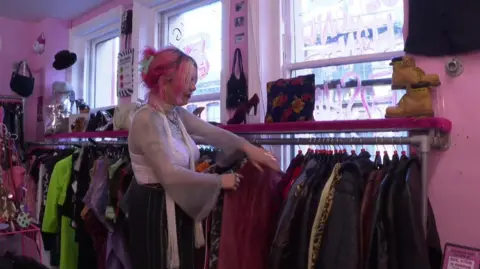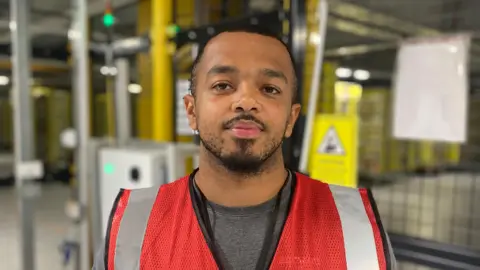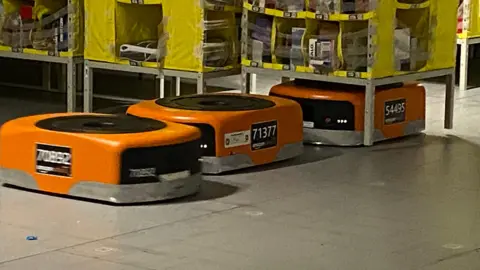Black Friday: The view from inside and outside Amazon
 BBC
BBCAt Amazon's giant warehouse on the outskirts of Manchester, men, women and robots work together to deal with the massive surge in orders that Black Friday inevitably brings.
A few miles away in the city centre, staff at independent emporium Afflecks brace themselves for a dip in trade.
The two buildings are both part of the same retail ecosystem, but one that some fear has become heavily imbalanced.
So how do small retailers fare in a market where one company alone - Amazon - must take on an extra 2,000 staff across the north-west of England just to deal with demand?

Afflecks retailer Megan Price says small independent sellers see a dip in trade as they "just cannot compete".
Ms Price is part of a collective of Manchester-based artists known as Swalk Creative who sell their artwork at affordable prices at the market.
"We're trying to offer value and affordability year round," she says, but adds it is a struggle to compete "when these massive companies are able to offer such enormous discounts".
Black Friday is also a worry for Erin Taylor-Thomas, owner of second-hand clothes store Beg Steal and Borrow.
"We already have low prices, so dropping it any lowers would just mean that we wouldn't make enough money to sustain what we've created here," she said.
And for Ms Taylor-Thomas, something else that is lost as shoppers are drawn to sales online is the "connection of gift-giving, being connected to people, and that experience".

Over in Altrincham at the Amazon warehouse, there is a thrum of activity.
Cole McGrath, who maintains the robots - known as drives - says he is expecting things to be "much busier" as the shopping frenzy peaks.
"It's definitely much busier on Black Friday, but there are no more or less issues; you can see a lot more movements in the warehouse, but the robots are doing their job."
But whose products are those drives moving around the warehouse floor, and in whose pocket is the money consumers spend on them ending up in?

Amazon says more than half of its product sales in the UK are from what it calls "independent selling partners" - most of them small to medium-sized firms.
It estimates about 100,000 such firms now sell through the site.
Neil Travis, the north west regional director for Amazon, says there is definitely a place for both the online retail behemoth and independent sellers.
He said 65% of the items at the Altrincham warehouse come from small to medium businesses in the UK, with more than 11,5000 sellers from the north west of England.
Listen to the best of BBC Radio Manchester on Sounds and follow BBC Manchester on Facebook, X, and Instagram. You can also send story ideas to [email protected] and via Whatsapp to 0808 100 2230.
